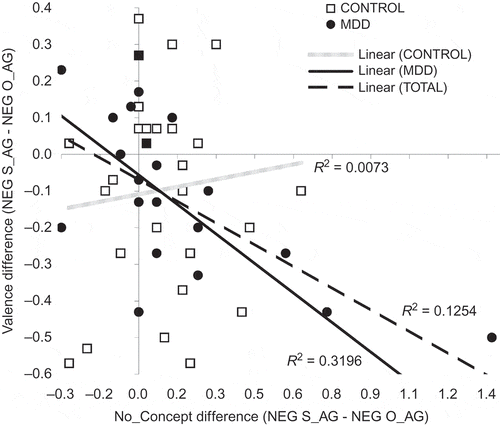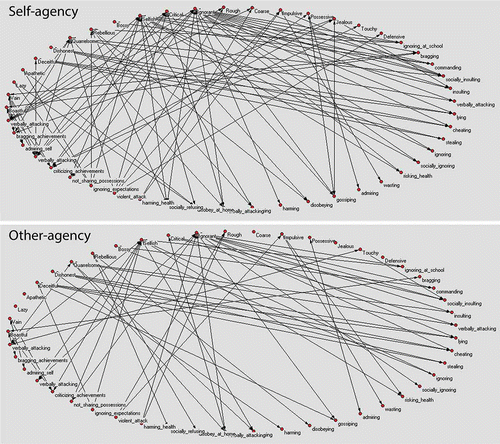Figures & data
Figure 1. An example screen from the CSKD task is depicted. Beneath the denoted social behavior, participants were presented with 19 negative social concepts in the negative condition (as displayed) and 19 positive social concept labels in the positive condition. Concepts were taken from our normative pre-study. Participants were provided with the instructions as displayed above. To clarify this instruction, participants were reminded by the experimenter that when choosing multiple concepts, “they should all be equally good labels of the described behavior.” Participants were asked to rate to what extent they would experience unpleasant or pleasant feelings (valence) as a result of the social behavior on a bipolar scale (–4 = extremely unpleasant to +4 = extremely pleasant).

Figure 2. Displayed are individual values of VALENCE scores = difference of mean valence (NEG_SA – NEG_OA) and CONCEPT scores = difference of mean number of concepts (NEG_SA – NEG_OA) for N = 56 participants (29 control, 27 MDD). A univariate AN(C)OVA (corrected model: R2 = .26, F = 6.2, p = .001) showed a main effect of VALENCE on CONCEPT (F = 6.5, p = .01) and an interaction of group by VALENCE (F = 9.2, p = .004) with no main effect of group (F = .09, p = .76). The interaction was due to people with MDD showing a higher interdependence of CONCEPT and VALENCE scores in the expected direction (MDD: B = −.60, t = −4.2, p < .0001; Control: B = .05, t = .33, p = .75) such that self-agency-selective conceptual overgeneralization (i.e., high CONCEPT scores) was associated with self-agency-selective negative valence biases (i.e., low VALENCE scores).

Figure 3. Displayed are connections between the 19 negative concepts and 30 social behaviors in the self-agency and other-agency condition made by one participant with remitted MDD (using PAJEK software for network analysis, (de Nooy, Mrvar, & Batgelj, Citation2005)). As can be seen, the participant used more concepts as descriptive of her own (92) relative to her best friend’s behavior (56) indicating conceptual overgeneralization for negative self- relative to the other-agency condition.

Figure 4. Regions showing increased coupling with the right superior ATL during the experience of guilt relative to indignation in individuals with lower (a) or higher (b) CONCEPT [NEG_S-AG – NEG_O-AG] (blue scale) or VALENCE [NEG_S-AG – NEG_O-AG] × CONCEPT [NEG_S-AG – NEG_O-AG] interaction (hot scale) scores irrespective of VALENCE scores and group. NEG_S-AG-selective conceptual differentiation (negative CONCEPT scores) was associated with left middle ATL increases in coupling for guilt (a) while high interdependence of conceptual overgeneralization and negative valence (more negative interaction scores) were associated with left superior ATL coupling increases for guilt (a). Higher coupling in right dorsolateral PFC and the septal part of the nucleus accumbens were associated with relative noninterdependence of conceptual overgeneralization and negative valence (i.e., more positive CONCEPT × VALENCE scores). Higher coupling in the same right dorsolateral PFC area and in the hypothalamus were also associated with higher NEG_S-AG-selective conceptual overgeneralization (i.e., higher CONCEPT scores). Cropped whole brain images were displayed at an uncorrected threshold of p = .005 (extent threshold of 4 voxels). All depicted regions survived FWE-correction over a priori ROIs at p = .05 in separate analyses.
![Figure 4. Regions showing increased coupling with the right superior ATL during the experience of guilt relative to indignation in individuals with lower (a) or higher (b) CONCEPT [NEG_S-AG – NEG_O-AG] (blue scale) or VALENCE [NEG_S-AG – NEG_O-AG] × CONCEPT [NEG_S-AG – NEG_O-AG] interaction (hot scale) scores irrespective of VALENCE scores and group. NEG_S-AG-selective conceptual differentiation (negative CONCEPT scores) was associated with left middle ATL increases in coupling for guilt (a) while high interdependence of conceptual overgeneralization and negative valence (more negative interaction scores) were associated with left superior ATL coupling increases for guilt (a). Higher coupling in right dorsolateral PFC and the septal part of the nucleus accumbens were associated with relative noninterdependence of conceptual overgeneralization and negative valence (i.e., more positive CONCEPT × VALENCE scores). Higher coupling in the same right dorsolateral PFC area and in the hypothalamus were also associated with higher NEG_S-AG-selective conceptual overgeneralization (i.e., higher CONCEPT scores). Cropped whole brain images were displayed at an uncorrected threshold of p = .005 (extent threshold of 4 voxels). All depicted regions survived FWE-correction over a priori ROIs at p = .05 in separate analyses.](/cms/asset/52127aff-7121-4095-bf5c-9456fb10686c/psns_a_810171_f0004_c.jpg)
TABLE 1 Individual differences on ATL-PPI effects for guilt versus indignation irrespective of group
Figure 5. (a) Displays right superior ATL coupling coefficients from the subgenual cingulate peak voxel of the positive effect of CONCEPT × VALENCE interaction scores on guilt versus indignation within the control group. Within this voxel, the control group showed higher ATL coupling for guilt versus indignation compared with the MDD group (CONTROL mean = 3.5 ± 4.7, MDD mean = −1.9 ± 4.4, t[43] = 4.02, p < .0001). (b) Depicts the subgenual, hypothalamic, right anterior dorsolateral PFC, medial and lateral frontopolar, and left temporo-parietal regions showing increased coupling for guilt versus indignation in control individuals with relative noninterdependence of conceptual overgeneralization and negative valence when appraising social behaviors (i.e., more positive CONCEPT × VALENCE interaction scores).
![Figure 5. (a) Displays right superior ATL coupling coefficients from the subgenual cingulate peak voxel of the positive effect of CONCEPT × VALENCE interaction scores on guilt versus indignation within the control group. Within this voxel, the control group showed higher ATL coupling for guilt versus indignation compared with the MDD group (CONTROL mean = 3.5 ± 4.7, MDD mean = −1.9 ± 4.4, t[43] = 4.02, p < .0001). (b) Depicts the subgenual, hypothalamic, right anterior dorsolateral PFC, medial and lateral frontopolar, and left temporo-parietal regions showing increased coupling for guilt versus indignation in control individuals with relative noninterdependence of conceptual overgeneralization and negative valence when appraising social behaviors (i.e., more positive CONCEPT × VALENCE interaction scores).](/cms/asset/b1dca4b2-b207-440e-8d3b-70963f570012/psns_a_810171_f0005_c.jpg)
TABLE 2 VALENCE × CONCEPT interaction score effects on ATL-PPI within each group